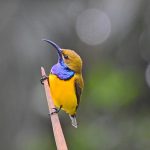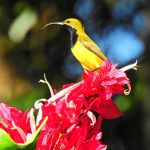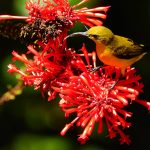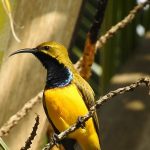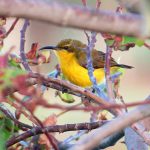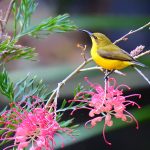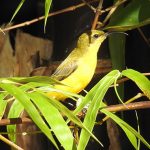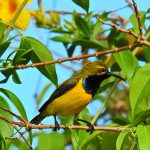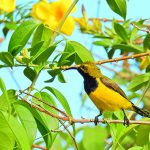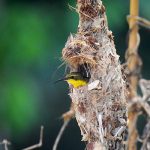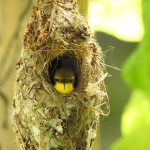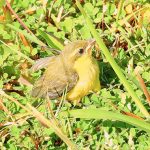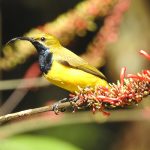OLIVE-BACKED SUNBIRD
The Olive-backed Sunbird is a small bird, typically around 10 to 12 centimetres in length. Males are particularly striking, featuring a glossy blue-black throat and upper chest, which contrast beautifully with their olive-green back and bright yellow underparts. Females, while less flamboyant, have an olive-green back and a more muted yellow underside, making them slightly less conspicuous. Both sexes have a slender, curved bill, adapted for their nectar-feeding habits.
In Australia, the Olive-backed Sunbird is primarily found in the tropical regions of northern Queensland. They prefer habitats such as mangroves, coastal forests, and gardens. Beyond Australia, their range extends across Southeast Asia, including countries like Thailand, Malaysia, the Philippines, and Indonesia. They are well-adapted to a variety of environments, from dense forests to urban areas with abundant flowering plants.
These sunbirds have a diet that mainly consists of nectar, which they extract from flowers using their specialised, brush-tipped tongues. This diet makes them important pollinators in their ecosystems. In addition to nectar, they also eat small insects and spiders, which are crucial for providing proteins, especially during the breeding season. As they feed on nectar, Olive-backed Sunbirds play a crucial role in pollinating various plant species, contributing to the health and diversity of their ecosystems.
These birds have shown a remarkable ability to adapt to urban environments, often seen in gardens and parks where flowering plants are plentiful.
Olive-backed Sunbirds are known for their distinctive nesting behaviour. The female constructs a hanging, purse-like nest made from plant fibres and spider silk, often positioned in sheltered locations such as under eaves or in dense foliage. The nest features a side entrance and is lined with soft materials for comfort. Typically, the female lays two to three eggs, which she incubates for about two weeks. After hatching, both parents participate in feeding the chicks.
While specific data on the lifespan of Olive-backed Sunbirds is limited, small birds like these typically live for several years in the wild, assuming they avoid predation and environmental threats.
The Olive-backed Sunbird has a cheerful and high-pitched call. Their song consists of sharp, rapid notes that sound like “tseet-tseet-tseet.” These calls are often used for communication between mates and to establish territorial boundaries.

